Contents
of the Winter 2014 Northants News
|
Mesembs
and more at Banstead
Roland
Tebbenham
|
Pictures
from Roland and Trev
As
many readers might know I do like mesembs. So this year I planned to attend the
Mesemb Study Group event in Banstead and the Birmingham Autumn Show. The former
is an exhibition of all the ‘mesemby’ genera (providing someone grows them
of course), the latter is a competitive affair, this year shared with the
Haworthia Society. There were 54 classes at the MSG event and 85 at Birmingham;
so both were significant events.
|
I
arrived at Banstead early to get the branch sales plants set up and stage
my two trays of exhibition plants, mainly Gibbaeum, small shrubby mesembs
and a couple of the Lithops
aberrant colour forms. Then a second breakfast was needed: a bacon
sandwich was the first of many excellent items produced by the sterling
band of helpers. Many people I meet every two years at Banstead were there
including Don Smith with whom I shared a sales table. He had some
interesting plants grown from habitat collected seed gathered during his
travels in South Africa and Namibia. He is seen with Jonathan Clarke,
Peter Arthurs and ‘The Man on the Bicycle’ Anthony Mitchell, who
explored South Africa in the 1970s and 80s. The people around the sales
tables were animated, and as sought-after plants were found, they
gradually drifted off to admire and discuss the exhibition plants.
Right:
Left to right; Jonathan
Clarke, Don Smith, Pete Arthurs and Anthony Mitchell; a quartet of mesemb
experts.
|

|
|

|
 |

|
|
Not
often seen in cultivation, the flowers of Don Smith’s Astridia
speciosa.
|
Namibia
cinerea |
Eddy
Harris’s Imitaria
muirii.
|
|
One
interesting aspect of the exhibition arrangement is that plants seldom
seen in competitive shows make an appearance. One example was Don
Smith’s Astridia
speciosa
with its lustrous white flower;
unfortunately
my Astridia
herrei
did not oblige with scarlet flowers this year. Another was the diminutive Namibia
cinerea
found NE of Luderitz and exhibited by John Watmough, an accomplished
mesemb grower. Other familiar plants included Eddy Harris’s Imitaria
muirii
and Peter Bent’s venerable pan full of Gibbaeum;
both have been on the tables for many years.
Large
trays of seedlings offered opportunities to appreciate the finer details
and beauty of plant structures: the Titanopsis species were fine examples.
Another benefit of this study-group event is that visitors can experience
the considerable variation in pots of lithops seedlings. Lithops
coleorum
and Lithops
julii
cv ‘Kikushogiyoko’ were notable in this respect.
Right:
Peter
Bent’s venerable pan full of Gibbaeum. |

|
|
 |
 |
Far
left: Seedling
Titanopsis
calcarea.
Left:
Seedling Titanopsis
schwantesii ‘primosii’
|
|
Though
with less variation there were many pots of conophytums in full flower;
however C.
burgeri
always grabs people’s attention. Derek Tribble not only brought many
plants for display, but also an exhibit of mesemb literature reflecting
how fortunate we are to have web resources and enjoy modern publishing
technology. He also staged an exhibit of mesemb
seed capsules, complete with
viewer and water-sprayer to encourage them to open as they would in
habitat to release seeds.
Right:
Derek Tribble’s
excellent display of mesemb seed capsules illustrating the variation
within the family. For more click here.
|

|
|

|
 |
Far
Left: Several plants of Lithops
coleorum SH1500
from the type location show some variation in size and colour.
Left:
Conophytum
burgeri (Ed:
And
no one is going to persuade me that even when they are well grown, as
here, they are worth growing!)
|
|
Right:
Plants
of Lithops
julii ‘Kikushogiyoko’.
Ed
At
least the label looks like this. I referred it to the Maces who referred
it to Keith Green who replied...
"The
correct spelling of some of the Japanese names is open to debate, but
currently I do not have any information on "Kikushogiyoku".
However, I suppose it is possible that some "Chinese whispers"
have corrupted some of the Japanese spellings.
What
I do have is information relating to 'Kikusiyo Giyoku', which is a
greenhouse hybrid of uncertain origin. It is a white flowering plant and
probably L. julii is involved. Basically the facial pattern is
a chrysanthemum crest as on the Japanese passport. It was established
in 1990 by Tony Sato, but the originator, Kisata Tanaka, has now I fear
passed away.”
|

|
|
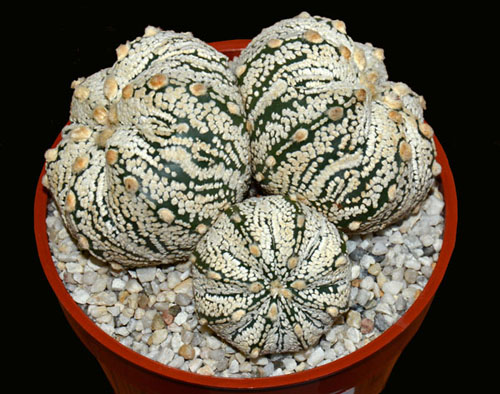
|
There
was an auction of twenty lots for the MSG Conservation & Research fund. It
commenced with a fine Stomatium garden, followed by mesemb books, plants, and an
‘honorary’ mesemb, a fine three-headed Astrophytum
‘Snowcap’ (Left). I managed to go home with a nice Lithops
julii
‘Peppermint Crème’ plant and a framed print of Aloe
parvula,
the work of the notable botanical artist Cynthia Letty. The auction also let me
see my complete set of ASPS journals go under the hammer to a new owner; she was
pleased to have them and the group has more funds to sponsor work in the field.
Left:
A great plant of Astrophytum
'Snowcap'.What is that doing here? Well it's an honorary mesemb when it is a
lot in the MSG Conservation Auction.
|
After
the many exhibition and sales tables were packed away we enjoyed a lecture by
Keith Green. He is a London paramedic and has spent many years visiting southern
Africa and has worked with Desmond and Naureen Cole and Tok Schoeman. Keith is
the International Cultivar Registration Authority for Lithops in accordance with
ICNCP arrangements and his website is a mine of useful data. Keith showed
pictures from his many visits to habitats during the past twenty years and he
explained that some populations were protected by their landowners, whereas
others have been damaged or are threatened with destruction. Human activities
are the principal threats, but the armoured ground cricket eats Lithops seeds
and hence reduces the plants’ abilities to maintain their populations. Some
poor local people ask visitors photographing plants if they are valuable. The
prudent response is ‘we didn’t find any and/or they aren’t worth
anything.’
He
went on to describe the project to re-introduce Lithops
werneri
to an important habitat. This was supported in part by the BCSS and 115
seedlings were planted in groups of 10-20 plants. Subsequent visits in 2013 and
2014 showed that many had survived, in particular those planted near Avonia
plants (the Avonias may work as indicators of suitable conditions). Indeed seed
capsules are now evident and some plants are now double-headed; a success
indeed. Keith summarised the overall situation as follows: “Some lithops
populations are safe, others are threatened and some sites have been lost.
Ex-situ conservation is vital and you must all take really good care of your
documented plants.” This was an important message to the attendees, echoed by
Suzanne in her words of thanks to Keith.
|

|
 |

|
|
Keith
Green’s display of new red cultivars, ‘Mahogany Lithops’.
|
Lithops
gesinae
var. annae
‘Hanawared’. Some redder than others. |
Lithops
karasmontana
‘Top Red’
|
In
my opinion Lithops cultivars are becoming more fashionable (as are those of
Astrophytums and Haworthias) and the exhibition at Banstead reinforced my view.
Keith Green himself put a neat exhibit entitled ‘Mahogany Lithops’ on the
table showing six examples. Two others took Trevor’s and my eyes; Lithops
gesinae
var. annae
‘Hanawared’ and Lithops
karasmontana
‘Top Red’, a vibrant red mesh-patterned cultivar first published in 2004.
Details of both of these can be found on Keith’s lithops scrapbook website.
The
cultivars are becoming much more widely available in commerce, but Tony Irons
was unable to get to Banstead and so I was prevented from taking more plants
home.
Fortunately
I was in Birmingham the following weekend and Tony was there with lots of lovely
Lithops, including many of of the newer cultivars! I managed to buy L
karasmontana
‘Top Red’, ‘Brick Red’ and ‘Blood Red’ (the latter two not
registered yet), also Lithops
bromfieldii var.
glaudinae
‘Embers’,
featured in Keith’s display, and
L
julii
‘Hotlips’.
They
will join my L
karasmontana
‘Sunstone’ and L.
‘Talisman’
both of which have flowered regularly in my greenhouse.
|
Overall
I made 21 entries in 13 classes at Birmingham and won 15 prize cards and the
Horace Burton Bowl for most points in the mesemb classes (I was fortunate that
other competitors did not enter all
six of the mesemb classes). Also both my Eriosyce
entries were placed in class-15 and I had ten new plants to take home so I had a
jolly good day. There were many excellent exhibits, lots of sales plants and a
good tombola, but my compact camera struggled to cope with the low light levels
in the show hall. However the succulent planting on the terrace and a fine Aloe
chabaudii
in flower in the arid house caught my eye.
Right:
(Ed) Roland won a second and
third in this Eriosyce class at the Birmingham Show.
Far
Right: Aloe
chabaudii
in flower in the Birmingham Botanical Garden arid greenhouse. |
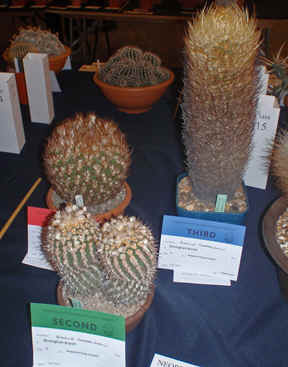 |
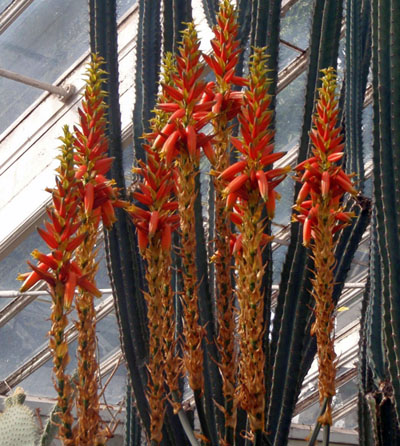 |
|
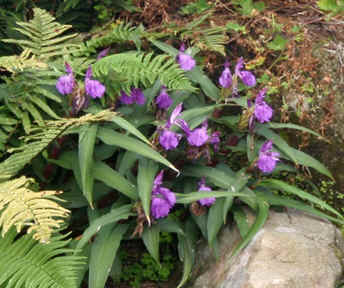
|
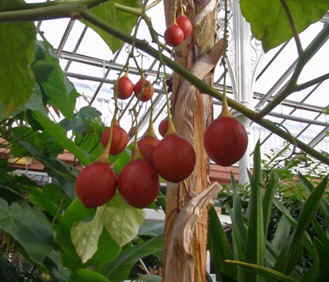 |
Far
Left:
Roscoea purpurea for the garden.
Left:
The 'tree tomato’ or Tamarillo, Cyphomandra
betacea
from the potato family growing in a Birmingham Botanical Garden glasshouse.
|
The
Botanic Gardens at Birmingham feature many interesting plants and were colourful
in the sunshine on show day. A clump of a new selection of
Roscoea
purpurea
(Zingiberaceae) was striking beside the rock-garden pool, Cercis
canadensis
(Fabaceae) glowed with autumnal tints and in the greenhouse a fine potful of Cyclamen
africanum
was in full flower. Finally an interesting Chilean member of the Solanaceae was
in fruit in the conservatory – ‘the tree tomato’ or Tamarillo Cyphomandra
betacea;
one for your greenhouse maybe? No, I think I will stick to mesembs.
Roland
Keith
Green’s interesting Lithops website is at www.scrapbooklithops.com/index.html]



















